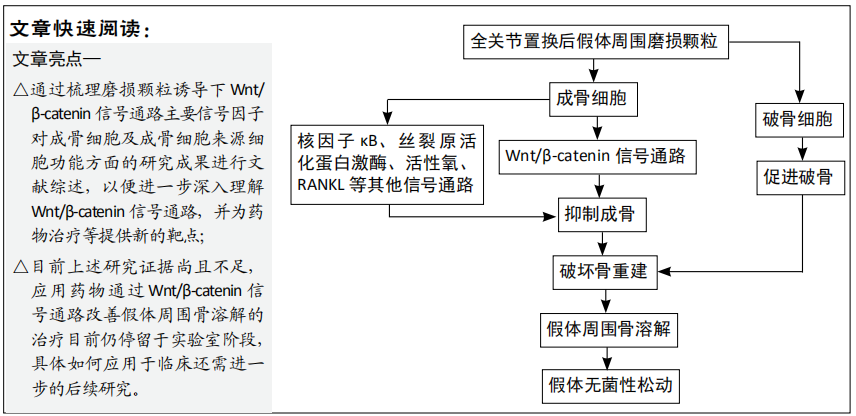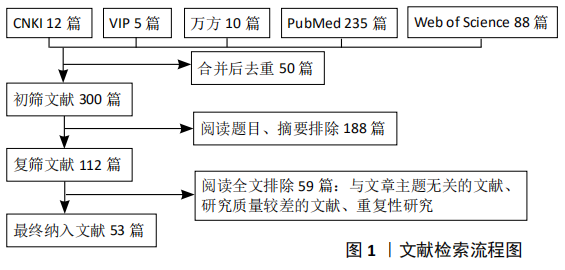[1] CAMUZARD O, BREUIL V, CARLE GF, et al. Autophagy Involvement in Aseptic Loosening of Arthroplasty Components. J Bone Joint Surg Am. 2019;101(5):466-472.
[2] LIMMER A, WIRTZ DC. Osteoimmunology: Influence of the Immune System on Bone Regeneration and Consumption. Z Orthop Unfall. 2017;155(3):273-280.
[3] YANG H, XU Y, ZHU M, et al. Inhibition of titanium-particle-induced inflammatory osteolysis after local administration of dopamine and suppression of osteoclastogenesis via D2-like receptor signaling pathway. Biomaterials. 2016;80:1-10.
[4] BAI F, CHEN X, YANG H, et al. Acetyl-11-Keto-β-Boswellic Acid Promotes Osteoblast Differentiation by Inhibiting Tumor Necrosis Factor-α and Nuclear Factor-κB Activity. J Craniofac Surg. 2018;29(7):1996-2002.
[5] GALLO J, GOODMAN SB, KONTTINEN YT, et al. Osteolysis around total knee arthroplasty: a review of pathogenetic mechanisms. Acta Biomater. 2013;9(9): 8046-8058.
[6] GENG DC, XU YZ, YANG HL, et al. Inhibition of titanium particle-induced inflammatory osteolysis through inactivation of cannabinoid receptor 2 by AM630. J Biomed Mater Res A. 2010;95(1): 321-326.
[7] GALLO J, GOODMAN SB, KONTTINEN YT, et al. Particle disease: biologic mechanisms of periprosthetic osteolysis in total hip arthroplasty. Innate Immun. 2013;19(2):213-224.
[8] BURTON L, PAGET D, BINDER NB, et al. Orthopedic wear debris mediated inflammatory osteolysis is mediated in part by NALP3 inflammasome activation. J Orthop Res. 2013;31(1):73-80.
[9] NAM JS, SHARMA AR, JAGGA S, et al. Suppression of osteogenic activity by regulation of WNT and BMP signaling during titanium particle induced osteolysis. J Biomed Mater Res A. 2017;105(3):912-926.
[10] CHIU R, SMITH KE, MA GK, et al. Polymethylmethacrylate particles impair osteoprogenitor viability and expression of osteogenic transcription factors Runx2, osterix, and Dlx5. J Orthop Res. 2010;28(5):571-577.
[11] FRITZ EA, JACOBS JJ, GLANT TT, et al. Chemokine IL-8 induction by particulate wear debris in osteoblasts is mediated by NF-kappaB. J Orthop Res. 2005;23(6):1249-1257.
[12] CHEN D, LI Y, GUO F, et al. Protective effect of p38 MAPK inhibitor on wear debris-induced inflammatory osteolysis through downregulating RANK/RANKL in a mouse model. Genet Mol Res. 2015;14(1):40-52.
[13] KIM JA, IHN HJ, PARK JY, et al. Inhibitory effects of triptolide on titanium particle-induced osteolysis and receptor activator of nuclear factor-κB ligand-mediated osteoclast differentiation. Int Orthop. 2015;39(1):173-182.
[14] CÓRDOVA LA, TRICHET V, ESCRIOU V, et al. Inhibition of osteolysis and increase of bone formation after local administration of siRNA-targeting RANK in a polyethylene particle-induced osteolysis model. Acta Biomater. 2015;13:150-158.
[15] AMIRHOSSEINI M, MADSEN RV, ESCOTT KJ, et al. GSK-3β inhibition suppresses instability-induced osteolysis by a dual action on osteoblast and osteoclast differentiation. J Cell Physiol. 2018;233(3):2398-2408.
[16] GENG D, WU J, SHAO H, et al. Pharmaceutical inhibition of glycogen synthetase kinase 3 beta suppresses wear debris-induced osteolysis. Biomaterials. 2015;69:12-21.
[17] GU Y, WANG Z, SHI J, et al. Titanium particle-induced osteogenic inhibition and bone destruction are mediated by the GSK-3β/β-catenin signal pathway. Cell Death Dis. 2017;8(6):e2878.
[18] XIONG L, LIU Y, ZHU F, et al. Acetyl-11-keto-β-boswellic acid attenuates titanium particle-induced osteogenic inhibition via activation of the GSK-3β/β-catenin signaling pathway. Theranostics. 2019;9(24):7140-7155.
[19] ARIOKA M, TAKAHASHI-YANAGA F, SASAKI M, et al. Acceleration of bone regeneration by local application of lithium: Wnt signal-mediated osteoblastogenesis and Wnt signal-independent suppression of osteoclastogenesis (vol 90, pg 397, 2014). Biochem Pharmacol. 2014;91(4):552-553.
[20] LOISELLE AE, LLOYD SA, PAUL EM, et al. Inhibition of GSK-3β rescues the impairments in bone formation and mechanical properties associated with fracture healing in osteoblast selective connexin 43 deficient mice. PLoS One. 2013;8(11):e81399.
[21] ETHERIDGE SL, SPENCER GJ, HEATH DJ, et al. Expression profiling and functional analysis of wnt signaling mechanisms in mesenchymal stem cells. Stem Cells. 2004;22(5):849-860.
[22] HANG K, YE C, XU J, et al. Apelin enhances the osteogenic differentiation of human bone marrow mesenchymal stem cells partly through Wnt/β-catenin signaling pathway. Stem Cell Res Ther. 2019;10(1):189.
[23] GLASS DA 2ND, BIALEK P, AHN JD, et al. Canonical Wnt signaling in differentiated osteoblasts controls osteoclast differentiation. Dev Cell. 2005;8(5):751-764.
[24] HOLMEN SL, ZYLSTRA CR, MUKHERJEE A, et al. Essential role of beta-catenin in postnatal bone acquisition. J Biol Chem, 2005;280(22):21162-21168.
[25] KRISHNAN V, BRYANT HU, MACDOUGALD OA. Regulation of bone mass by Wnt signaling. J Clin Invest. 2006;116(5):1202-1209.
[26] KRAMER I, HALLEUX C, KELLER H, et al. Osteocyte Wnt/beta-catenin signaling is required for normal bone homeostasis. Mol Cell Biol. 2010;30(12):3071-3085.
[27] ALAM I, ALKHOULI M, GERARD-O’RILEY RL, et al. Osteoblast-Specific Overexpression of Human WNT16 Increases Both Cortical and Trabecular Bone Mass and Structure in Mice. Endocrinology. 2016;157(2):722-736.
[28] MARTINEAU X, ABED É, MARTEL-PELLETIER J, et al. Alteration of Wnt5a expression and of the non-canonical Wnt/PCP and Wnt/PKC-Ca2+ pathways in human osteoarthritis osteoblasts. PLoS One. 2017;12(8):e0180711.
[29] OKAMOTO M, UDAGAWA N, UEHARA S, et al. Noncanonical Wnt5a enhances Wnt/β-catenin signaling during osteoblastogenesis. Sci Rep. 2014;4:4493.
[30] SONG L, LIU M, ONO N, et al. Loss of wnt/β-catenin signaling causes cell fate shift of preosteoblasts from osteoblasts to adipocytes. J Bone Miner Res. 2012;27(11): 2344-2358.
[31] KIDA J, HATA K, NAKAMURA E, et al. Interaction of LEF1 with TAZ is necessary for the osteoblastogenic activity of Wnt3a. Sci Rep. 2018;8(1):10375.
[32] PARK HW, KIM YC, YU B, et al. Alternative Wnt Signaling Activates YAP/TAZ. Cell. 2015;162(4): 780-794.
[33] XIONG J, ALMEIDA M, O’BRIEN CA. The YAP/TAZ transcriptional co-activators have opposing effects at different stages of osteoblast differentiation. Bone. 2018;112:1-9.
[34] ZHU C, ZHENG XF, YANG YH, et al. LGR4 acts as a key receptor for R-spondin 2 to promote osteogenesis through Wnt signaling pathway. Cell Signal. 2016;28(8): 989-1000.
[35] LEE SS, SHARMA AR, CHOI BS, et al. The effect of TNFα secreted from macrophages activated by titanium particles on osteogenic activity regulated by WNT/BMP signaling in osteoprogenitor cells. Biomaterials. 2012;33(17):4251-4263.
[36] LIU S, VIRDI AS, SENA K, et al. Sclerostin antibody prevents particle-induced implant loosening by stimulating bone formation and inhibiting bone resorption in a rat model. Arthritis Rheum. 2012;64(12):4012-4020.
[37] GENG T, SUN S, YU H, et al. Strontium ranelate inhibits wear particle-induced aseptic loosening in mice. Braz J Med Biol Res. 2018;51(9):e7414.
[38] QU R, CHEN X, YUAN Y, et al. Ghrelin Fights Against Titanium Particle-Induced Inflammatory Osteolysis Through Activation of β-Catenin Signaling Pathway. Inflammation. 2019;42(5):1652-1665.
[39] ZHANG ZH, JIA XY, FANG JY, et al. Reduction of SOST gene promotes bone formation through the Wnt/β-catenin signalling pathway and compensates particle-induced osteolysis. J Cell Mol Med. 2020;24(7): 4233-4244.
[40] WANG L, BAI J, WANG Q, et al. Inhibition of protein phosphatase 2A attenuates titanium-particle induced suppression of bone formation. Int J Biol Macromol. 2020;142:142-151.
[41] NILSSON A, NORGARD M, ANDERSSON G, et al. Fluid pressure induces osteoclast differentiation comparably to titanium particles but through a molecular pathway only partly involving TNFalpha. J Cell Biochem. 2012;113(4):1224-1234.
[42] FAHLGREN A, BOSTROM MPG, YANG X, et al. Fluid pressure and flow as a cause of bone resorption. Acta Orthop. 2010;81(4):508-516.
[43] AMIRHOSSEINI M, ANDERSSON G, ASPENBERG P, et al. Mechanical instability and titanium particles induce similar transcriptomic changes in a rat model for periprosthetic osteolysis and aseptic loosening. Bone Rep. 2017;7:17-25.
[44] TANG YH, YUE ZS, LI GS, et al. Effect of β‑ecdysterone on glucocorticoid‑induced apoptosis and autophagy in osteoblasts. Mol Med Rep. 2018;17(1):158-164.
[45] KANG C, WEI L, SONG B, et al. Involvement of autophagy in tantalum nanoparticle-induced osteoblast proliferation. Int. J. Nanomed. 2017;12:4323.
[46] KIM IR, KIM SE, BAEK HS, et al. The role of kaempferol-induced autophagy on difffferentiation and mineralization of osteoblastic MC3T3-E1 cells. BMC Complement Altern. 2016;16:333.
[47] WANG Z, LIU N, LIU K, et al. Autophagy mediated CoCrMo particle-induced peri-implant osteolysis by promoting osteoblast apoptosis. Autophagy. 2015;11(12): 2358-2369.
[48] ZHANG X, YIN H, LI Z, et al. Nano-TiO 2 induces autophagy to protect against cell death through antioxidative mechanism in podocytes. Cell Biol. Toxicol. 2016;32: 513-527.
[49] YANG L, MENG H, YANG M. Autophagy protects osteoblasts from advanced glycation end products-induced apoptosis through intracellular reactive oxygen species. J Mol Endocrinol. 2016;56:291-300.
[50] ZHANG DY, WANG HJ, TAN YZ. Wnt/β-catenin signaling induces the aging of mesenchymal stem cells through the DNA damage response and the p53/p21 pathway. PLoS One. 2011;6(6):e21397.
[51] XIA W, ZHUANG L, DENG X, et al. Long noncoding RNA-p21 modulates cellular senescence via the Wnt/β-catenin signaling pathway in mesenchymal stem cells. Mol Med Rep. 2017;16(5):7039-7047.
[52] CHEN J, JIA YS, LIU GZ, et al. Role of LncRNA TUG1 in intervertebral disc degeneration and nucleus pulposus cells via regulating Wnt/β-catenin signaling pathway. Biochem Biophys Res Commun. 2017;491(3):668-674.
[53] LAI XH, LEI Y, YANG J, et al. Effect of microRNA-34a/SIRT1/p53 signal pathway on notoginsenoside R1 delaying vascular endothelial cell senescence. Zhongguo Zhong Yao Za Zhi. 2018;43(3):577-584. |


